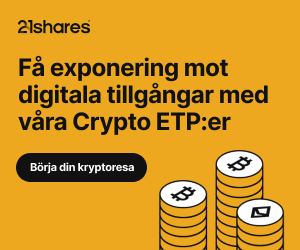Nyheter
Gold outlook 2017 further upside likely
Publicerad
8 år sedanden
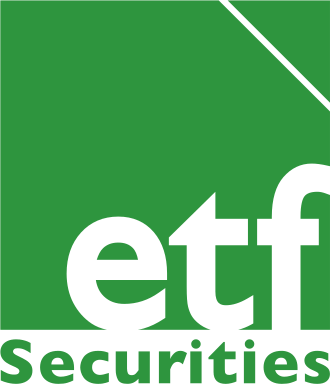
Commodity Research Gold outlook 2017 further upside likely
Highlights
- While the US Federal Reserve (Fed) will increase rates this year, inflation will remain stubbornly high, maintaining a low real rate environment. Gold could rise to $1300/oz (8%) in the first half of the year, aided by a weaker US Dollar (USD). However, USD strengthening in the second half of the year and subdued enthusiasm for the metal in the futures market could drive a sell-off, with gold ending the year at US$1230/oz.
- While the US Federal Reserve (Fed) will increase rates this year, inflation will remain stubbornly high, maintaining a low real rate environment. Gold prices could rise 8% in the first half of the year, aided by a weaker US Dollar (USD). However, USD strengthening in the second half of the year and subdued enthusiasm for the metal in the futures market could drive a sell-off, with gold ending the year at US$1230/oz, just 2.5% higher than today.
- In a bullish scenario for gold, the Fed will be slow to act and inflation will be markedly above market expectations, while the USD weakens. Gold would end the year at US$1380/oz (15%).
In a bearish scenario for gold, the Fed will move more aggressively, seeing the USD appreciate and burst the bond market bubble. Gold would end the year at US$1095/oz (-9%).
2017 gold price forecast
Gold has had a strong start to the year with the metal having risen 3.6% so far. We expect gold to end the year at US$1230/oz, up from US$1185/oz (2.5%). However, gold could peak at a higher level, at around US$1300/oz mid-year (+8%). Our projections on gold are based on the model we presented in “Policy mistakes provide upside potential for gold”. We also present a more bullish and bearish scenario in addition to our base case.
(Click to enlarge)
Inflation to surprise on the upside
US inflation is rising rapidly. Higher energy prices today compared with a year ago will likely see inflation rise substantially above the Federal Reserve’s target of 2%. Aside from the volatile energy component, core prices are likely to rise as the US labour market shows signs of tightness. The unemployment rate at 4.7% is close to the ‘natural rate’, indicating that any further improvement will be highly inflationary. We believe that headline inflation will reach 2.9% in the first half of the year as a result of higher energy prices compared to a year ago, but even as the base effect fades, inflation will remain elevated at 2.7% in the second half. Inflation will rise despite the Fed delivering on all three rate hikes implied in its ‘dot plots’. Inflation will be substantially higher than the Fed’s projection of 1.9% and the consensus view of 2.5%.
(Click to enlarge)
Dollar appreciation to follow depreciation
As discussed in “Near-term downside for US Dollar”, we expect the USD to depreciate in the near-term after the currency has risen too far, too fast. The risk of the Fed’s actions not living up to its rhetoric is likely to place downward pressure on the currency. USD could fall as much as 2% from today’s levels in the first half of the year. As the Fed comes to terms with having to be more active with monetary policy in mid-2017, we feel that the USD could stage a rebound. The USD is likely to end the year 3% higher than today.
Nominal bond yields rise
Nominal bond yields are expected to rise as the Fed raises policy interest rates. We expect the Fed to deliver all three of the rate hikes indicated in its ‘dot plot’. Although policy rates will increase by 0.75%, we believe that nominal US 10-year bond yields will increase by 0.5% by year-end (from 2.5% to 3.0%) as we typically see the yield curve flatten in rate rising environments.
(Click to enlarge)
With inflation remaining elevated, despite the increase in nominal yields, real yields will be low and could even decline from just under 0.5% currently. Given gold’s historic negative relationship with real rates, a rising nominal rate environment is still consistent with rising gold prices.
(Click to enlarge)
Positioning less sensitive to shocks
Market sentiment toward gold has become subdued. Speculative positioning in gold futures has fallen drastically from last year. In July 2016 speculative positioning in gold futures reached an all-time high of 347,445 net long contracts as the shock result of Brexit led market participants toward the haven asset. But other shocks failed to muster as much enthusiasm for the metal. The surprise win for President Trump or the rejection of constitutional reform in Italy for example had little lasting support for the metal in terms of price or positioning. Speculative positioning fell below 100,000 contracts by the end of the year. It appears that the market has become desensitised by shock events. We think there could be a small uptick in positioning due to the French Dutch and German elections this year, but not to the levels we saw last year. There is also the risk that market uncertainty around Trump’s policies drives more investment in gold futures. We expect positioning to rise to 120,000 (which is markedly lower than the average of 220,000 last year).
(Click to enlarge)
Bull case
In a scenario where the Fed only increases rates twice this year while inflation rises to 3.2%, the USD could lose further ground, depreciating by 1%. More marked curve flattening could see nominal rates only rise to 2.7%. If markets become more responsive to shocks, speculative positions could move higher to 200,000 (close to the average positioning for last year). Under this scenario gold could rise to US$1380/oz by year end.
Bear case
In a scenario where the Fed tries to get ahead of the curve and reduce the risk higher inflation becoming entrenched into expectations, the central bank could raise rates four times this year. Most of the impact on inflation will only be felt in 2018, with inflation at the end of 2017 still around 2.4%. However, the USD may appreciate 5% while bond yields rise to 3.3%, a scenario consistent with the end of the bond market bubble. With markets more focused on a tightening monetary environment rather than political stress points, speculative positioning in gold could fall to 40,000 (significantly below the long term average of 88,000 net long contracts). Our model indicates that gold would fall to US$1095/oz in such a scenario by year end.
For more information contact:
ETF Securities Research team
ETF Securities (UK) Limited
T +44 (0) 207 448 4336
E info@etfsecurities.com
Important Information
The analyses in the above tables are purely for information purposes. They do not reflect the performance of any ETF Securities’ products . The futures and roll returns are not necessarily investable.
Du kanske gillar
-
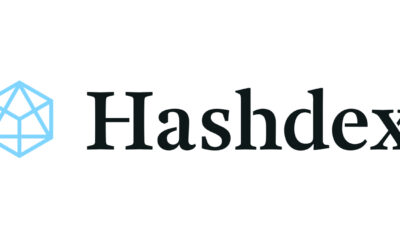

Can crypto outperform amidst the current market turmoil?
-
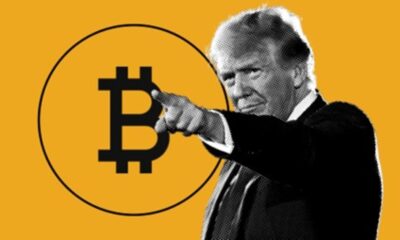

Trump’s trade war puts Bitcoin in the spotlight
-
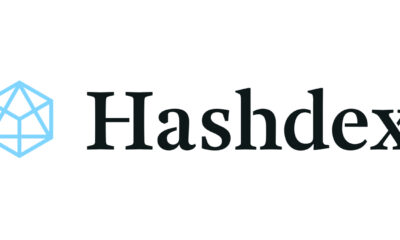

Prices respond to Trump’s return
-
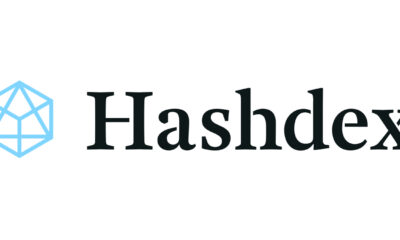

Crypto responds to Trump’s Executive Order and Japan’s rate hike
-
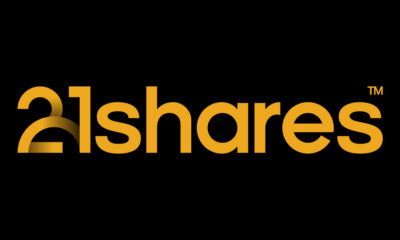

Trump 2.0: The Art of the Crypto Deal
-
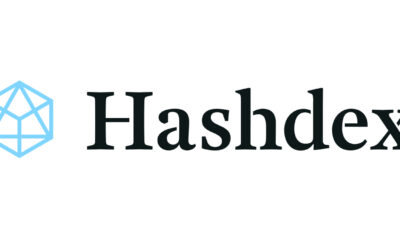

Trump’s inauguration day, BTC all-time high and the US election bullish effect
Nyheter
From digital asset to safe haven: Why is Bitcoin acting like gold?
Publicerad
20 timmar sedanden
28 april, 2025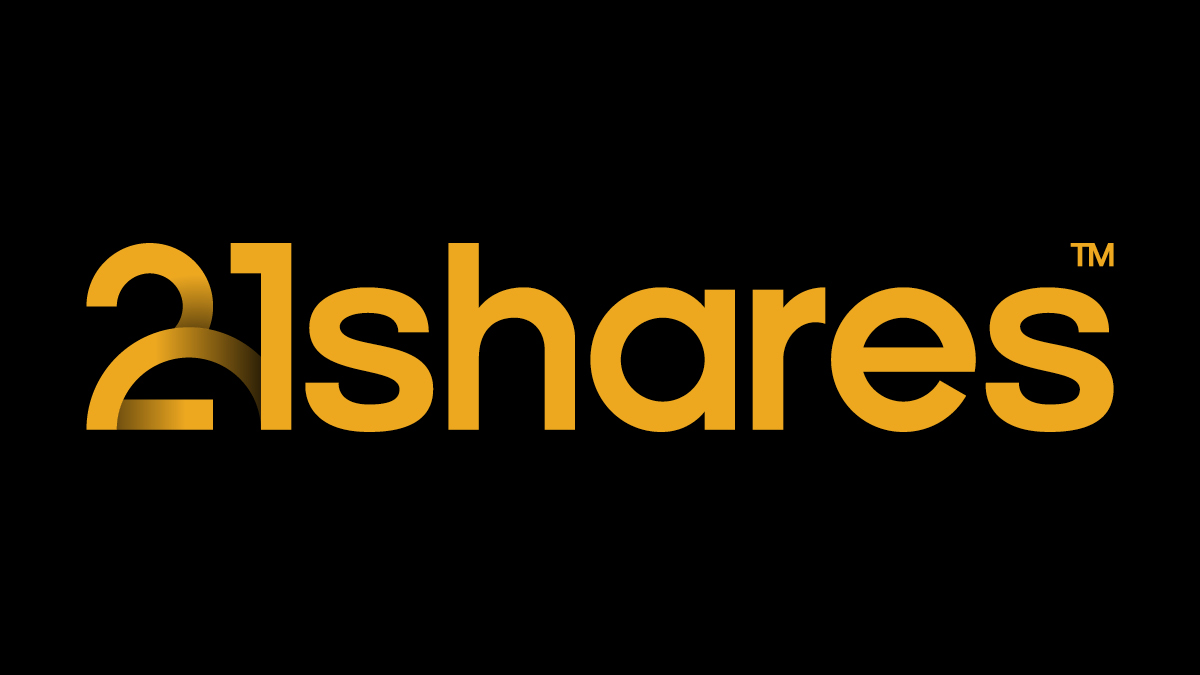
Bitcoin’s price has taken a different path from U.S. stocks over the past weeks. While major indexes such as the S&P 500 and Nasdaq have experienced declines, Bitcoin has risen to its highest levels in recent months, positioning itself as a safe haven, similar to gold. Understand how Bitcoin and gold have been synced for some time and what the correlation might look like in the future.
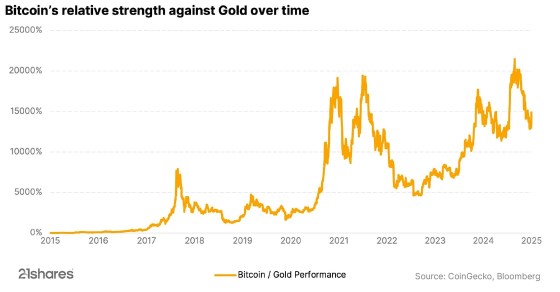

Ethereum’s big reboot: Why investors should be excited
Ethereum is making headlines due to a potential change in its core software, the Ethereum Virtual Machine (EVM), that operates across thousands of computers, enabling Ethereum to execute smart contracts and securely track transactions. However, Ethereum’s co-founder, Vitalik Buterin, has suggested replacing the EVM with a new system called RISC-V. Discover why the change is necessary and its potential impact on investors.
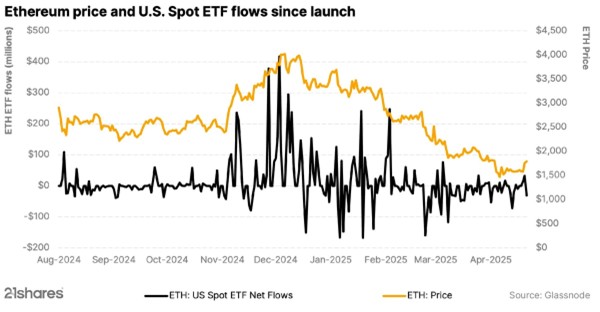


Thousands of altcoins, but no altcoin season: What comes next?
Over the past year, the crypto market has entered a new era. Bitcoin hit new all-time highs, outperforming other cryptocurrencies and decoupling from the stock market. Unlike previous cycles, the expected “altcoin season” did not occur, with Bitcoin remaining strong and money not flowing into other cryptocurrencies or altcoins. So, the big question is: Has altcoin season run its course?
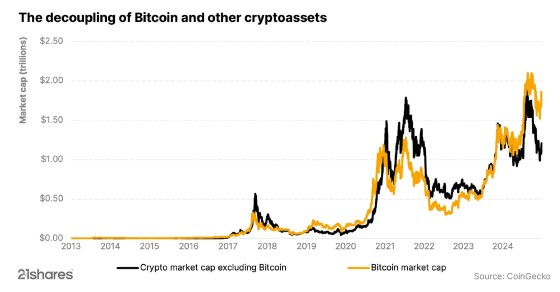

Research Newsletter
Each week the 21Shares Research team will publish our data-driven insights into the crypto asset world through this newsletter. Please direct any comments, questions, and words of feedback to research@21shares.com
Disclaimer
The information provided does not constitute a prospectus or other offering material and does not contain or constitute an offer to sell or a solicitation of any offer to buy securities in any jurisdiction. Some of the information published herein may contain forward-looking statements. Readers are cautioned that any such forward-looking statements are not guarantees of future performance and involve risks and uncertainties and that actual results may differ materially from those in the forward-looking statements as a result of various factors. The information contained herein may not be considered as economic, legal, tax or other advice and users are cautioned to base investment decisions or other decisions solely on the content hereof.
Nyheter
WELC ETF ger exponering mot företag inom sällanköpsvaror
Publicerad
21 timmar sedanden
28 april, 2025
Amundi S&P Global Consumer Discretionary ESG UCITS ETF DR EUR (D) (WELC ETF) med ISIN IE00061J0RC6, strävar efter att spåra S&P Developed Ex-Korea LargeMidCap Sustainability Enhanced Consumer Discretionary index. Det S&P-utvecklade ex-Korea LargeMidCap Sustainability Enhanced Consumer Discretionary-indexet spårar stora och medelstora företag från den diskretionära konsumentsektorn. ESG-kriterier (miljö, social och bolagsstyrning) beaktas vid valet av värdepapper.
Den börshandlade fondens TER (total cost ratio) uppgår till 0,18% p.a.. Amundi S&P Global Consumer Discretionary ESG UCITS ETF DR EUR (D) är den billigaste ETF som följer S&P Developed Ex-Korea LargeMidCap Sustainability Enhanced Consumer Discretionary index. ETFen replikerar det underliggande indexets prestanda genom fullständig replikering (köper alla indexbeståndsdelar). Utdelningarna i ETFen delas ut till investerarna (Årligen).
Amundi S&P Global Consumer Discretionary ESG UCITS ETF DR EUR (D) är en mycket liten ETF med 5 miljoner euro förvaltade tillgångar. Denna ETF lanserades den 20 september 2022 och har sin hemvist i Irland.
Investeringsmål
AMUNDI S&P GLOBAL CONSUMER DISCRETIONARY ESG UCITS ETF DR – EUR (D) försöker replikera, så nära som möjligt, resultatet för S&P Developed Ex-Korea LargeMidCap Sustainability Enhanced Consumer Discretionary Index (Netto Total Return Index). Denna ETF har exponering mot stora och medelstora företag i utvecklade länder. Den innehåller uteslutningskriterier för tobak, kontroversiella vapen, civila och militära handeldvapen, termiskt kol, olja och gas (inkl. Arctic Oil & Gas), oljesand, skiffergas. Den är också utformad för att välja ut och omvikta företag för att tillsammans förbättra hållbarhet och ESG-profiler, uppfylla miljömål och minska koldioxidavtrycket.
Handla WELC ETF
Amundi S&P Global Consumer Discretionary ESG UCITS ETF DR EUR (D) (WELC ETF) är en europeisk börshandlad fond. Denna fond handlas på flera olika börser, till exempel Deutsche Boerse Xetra.
Det betyder att det går att handla andelar i denna ETF genom de flesta svenska banker och Internetmäklare, till exempel Nordnet, SAVR, DEGIRO och Avanza.
Börsnoteringar
Största innehav
Denna fond använder fysisk replikering för att spåra indexets prestanda.
| Namn | Valuta | Vikt % | Sektor |
| AMAZON.COM INC | USD | 18.89 % | Sällanköpsvaror |
| TESLA INC | USD | 13.29 % | Sällanköpsvaror |
| HOME DEPOT INC | USD | 5.75 % | Sällanköpsvaror |
| LVMH MOET HENNESSY LOUIS VUI | EUR | 5.44 % | Sällanköpsvaror |
| TOYOTA MOTOR CORP | JPY | 4.58 % | Sällanköpsvaror |
| MCDONALD S CORP COM NPV | USD | 2.63 % | Sällanköpsvaror |
| LOWE S COS INC COM US 0.50 | USD | 2.38 % | Sällanköpsvaror |
| SONY GROUP CORP (JT) | JPY | 2.25 % | Sällanköpsvaror |
| BOOKING HOLDINGS INC | USD | 2.02 % | Sällanköpsvaror |
| TJX COMPANIES INC | USD | 1.89 % | Sällanköpsvaror |
Innehav kan komma att förändras
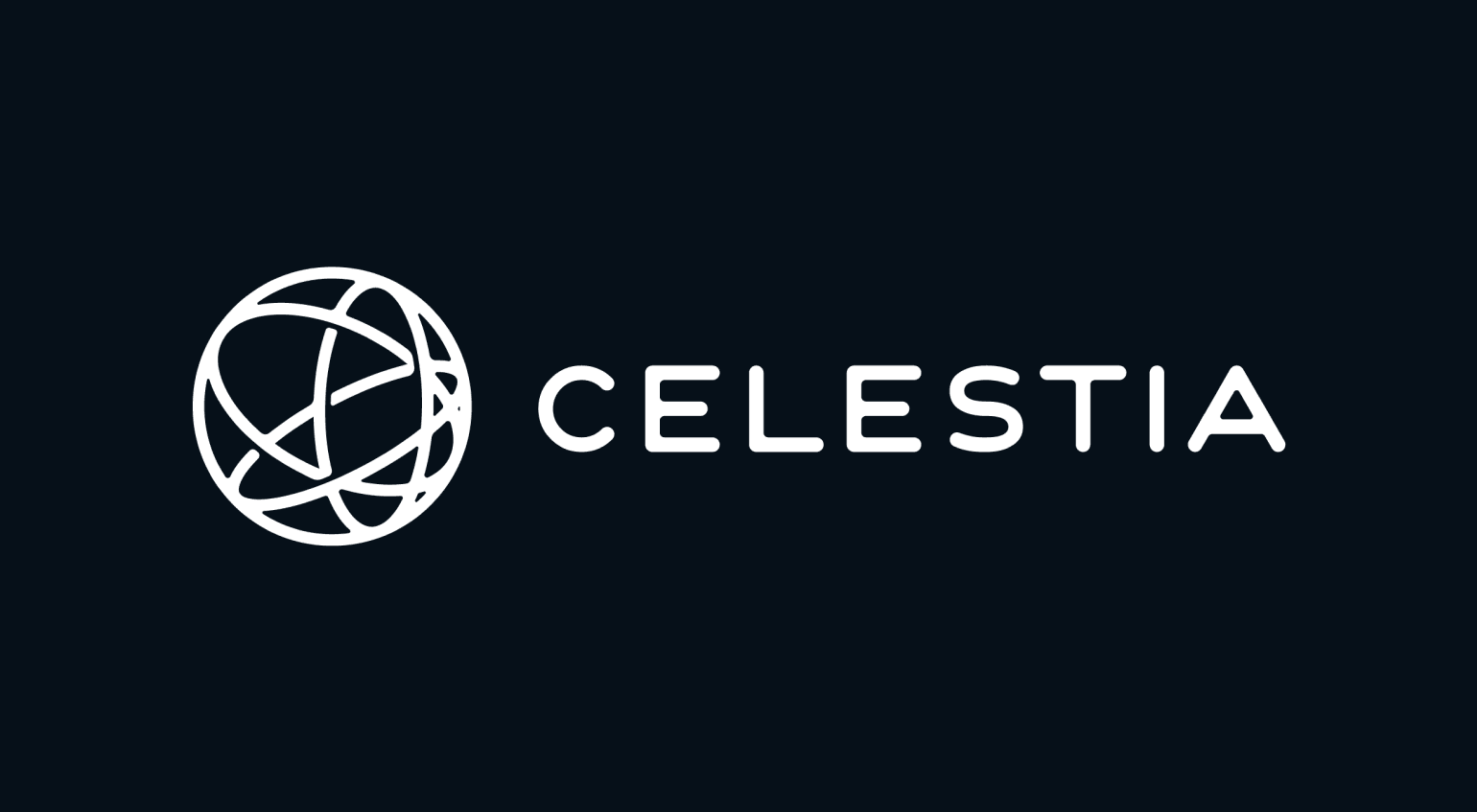
To understand Celestia’s value and its role in the ecosystem, it’s helpful to first understand how traditional blockchain systems are structured.
Most blockchains, like Ethereum or Bitcoin, are monolithic which means they perform all major functions (consensus, data availability, and execution) on a single layer. This design ensures security but according to new modular networks, limits scalability and flexibility.
The modular blockchain thesis, which Celestia is leading, proposes separation of layers and respective responsibilities in the network. Instead of having one network and its validators perform all of its functions, it may be better to have specialized layers:
• Consensus Layer: Ensures that all nodes agree on the order of transactions.
• Data Availability Layer: Ensures transaction data is accessible to all participants.
• Execution Layer: Processes the actual logic and computation of smart contracts.
By unbundling these components, developers can build more efficient, flexible systems that scale far beyond what monolithic blockchains can support. Not all applications need similar levels of security and not all applications need to scale up to millions of transactions. Additionally, one application might be scaling beyond the capabilities of its host network, severely effecting the available data throughput of other applications. This limits developers to the monolithic technology stack provided by a virtual machine such as Ethereum’ EVM.
The Issue of Data Availability
One of the most misunderstood yet crucial components of any blockchain is data availability. In simple terms, it ensures that the data behind each block is fully accessible and verifiable by all participants in the network. Another way to describe it is as the confidence a user can have that the data required to verify a block is really available to all network participants. Data availability is therefore important to all stakeholders of the blockchain ecosystem.
If a block producer withholds data, then nodes cannot verify the block, which leads to potential censorship or fraud.
Traditionally, a blockchain network can offer data availability with the following mechanisms:
• Full Replication: Every node stores the entire blockchain and verifies all data. Secure but not quite scalable.
• Sharding: Breaks the blockchain into smaller pieces (shards), spreading data across nodes. Scalable but highly complex to implement.
• Committee-Based Models: Small groups of nodes are trusted to verify data availability. Efficient, but less decentralized.
Celestia takes a completely different approach using a novel method called Data Availability Sampling (DAS). Instead of requiring every node to download all data, DAS allows lightweight nodes to randomly sample small chunks of a block. If enough pieces are retrievable, the node can confidently assume the full block is available. This slashes resource requirements while maintaining security and decentralization.
Why Data Availability Matters
Data availability might sound like a nerdy technical term, but it’s one of the most important yet one of less invisible parts of how blockchains work.
Let’s say you’re using a crypto app to trade tokens, store art, or move money. Every time you do something, that action (also referred to as a transaction) needs to be recorded and shared with the rest of the network so everyone agrees it happened. If that data disappears or can’t be verified, the whole system becomes untrustworthy. You might think your tokens moved but if no one else can see that record or a different version of that record, it’s as if it never happened.
Here’s a real-life parallel: imagine a public scoreboard at a sports game. If the scorekeeper shows the score to only a few people and then hides the board, how can the rest of the crowd trust the result? Everyone needs to see the score to believe it’s fair. In crypto, data availability is what makes sure the scoreboard is always visible to all participants at any time.
How DAS Changes the Game
Traditionally, ensuring data availability meant every node had to download and verify the entire block of data for any purpose related to particular data inside the block, like reading a whole newspaper just to check one article. Ethereum and most competing monolithic layer-1’s operate this way. It works, but it’s expensive, slow, and becomes less practical as blockchains scale in terms of data throughput required by its Dapps therefore limiting the types of applications that developers can build.
Celestia’s Data Availability Sampling (DAS) is a breakthrough that lets even simple devices (like smartphones) verify that a block’s data is available—by checking just a few random pieces. If enough pieces are found and correct, the network can be confident the full block is truly there and correct.
This innovation means:
• Light clients can safely participate in the network without downloading everything.
• Rollups and app-chains can post their data to Celestia with minimal overhead.
• Scalability skyrockets without sacrificing decentralization.
Celestia’s Role in Scaling Applications
Celestia is the first blockchain designed specifically to be a modular data availability layer. That means it doesn’t execute smart contracts or handle transactions directly, instead, it provides a foundation for others to build new networks, also referred to as rollups.
Developers can launch rollups or full execution environments, and use Celestia to handle the consensus and data availability side. This unlocks several key benefits:
• Massive scalability: Apps can scale independently from each other.
• Customization: Developers choose their own virtual machines, consensus mechanism and execution logic.
• Decentralization: Thanks to DAS, even small devices can validate the system.
This approach flips the script on how we think about launching and scaling blockchains. Instead of competing for space on a monolithic chain, apps get their own chains, backed by Celestia’s secure and scalable data availability layer while giving developers full stack control over their applications.
Celestia Enables Scalability and Offers Full-Stack Control
Using the restaurant example from Sui vs Aptos. Imagine a big, busy restaurant where the chefs, waiters, and cashiers all work in the same small kitchen. It gets crowded, orders take forever, and sometimes things go wrong while the backlog of orders keeps growing. That’s how traditional blockchains work, doing everything in one place.
Now imagine if the restaurant separated the jobs: the chefs cook in a big kitchen, waiters serve from a clean dining area, and the cashiers handle payments at the front desk. Everything runs smoother, faster, and the restaurant can grow in a environment that is less prone to congestion. That is what Celestia is doing for blockchains. Let’s say a small specialty restaurant opens up next door, leveraging Celestia’s register and order management system. That new restaurant can fully focus on delivering the best food and experience to customers, knowing that Celestia’s technology won’t be the limiting factor when scaling up their kitchen. The modularity that Celestia’s restaurant offers is allowing a lot of small scale restaurants to exist without the overhead of individual administrative work. It goes even a step further, Celestia allows you to just use it register while letting smaller restaurants pick their own kitchen (execution environment) and order management system (consensus layer).
In conclusion, Celestia is challenging the believe that blockchains should always be monolithic and blockchains need to offer the same technology stack to all developers on its chain. It is a significant leap forward in the crypto ecosystem and opens possibilities that were previously not feasible.
Diversify Crypto Exposure to Modular Blockchain Technology with the VanEck Celestia ETN
Key features of the VanEck Celestia ETN
• Celestia enables secure scaling of blockchain applications with modular technology.
• Fully-collateralized by TIA in cold-storage.
• Total return of TIA: Tracks the MarketVector™ Celestia VWAP Close Index (MVTIAV).
Why VanEck Crypto ETNs? Here’s why:
• With nearly 70 years in asset management and a strong track record in crypto, we bring deep industry knowledge and proven reliability.
• We combine traditional financial strengths with cutting-edge crypto innovation, backed by a CEO who truly believes in crypto’s future.
• We ensure clarity in our product structures and avoid high-risk or opaque practices, with assets fully backed by cryptocurrency in secure cold storage.
• Our assets are secured by a licensed European bank in Liechtenstein, providing top-tier compliance and security.
• We use the safest institutional custody setup available, prioritizing your security over cost savings.
Crypto is an asset class with high potential returns but investing in digital assets comes with great risk, why choose products that potentially introduce even more risks? Choose VanEck for a secure, transparent, and expertly managed crypto investment experience.
Main Risk Factors:
Investors should note that there is no direct ownership for the crypto assets, but a claim against Issuer to receive such assets.
• Complexity risk: The complexity of the project and its technological concepts make it challenging to assess its viability and valuation.
• Adoption risk: Celestia introduces additional adoption risk as it is uncertain if the concept of modular blockchains will succeed.
• Technology risk: Celestia introduces additional technology risk due to the technology being less mature and therefore could be more prone to bugs and exploits.
• Regulatory Risk: market disruptions and governmental interventions may make digital assets illegal.
• Risk of Losses and Volatility: The trading prices of many digital assets have experienced extreme volatility in recent periods and may continue to do so. There is a risk of total loss as no guarantee can be made regarding custody due to hacking risk, counterparty risk and market risk.
• Other risks specific to this ETN’s Digital Assets can also be found on the VanEck Crypto Academy.
This is not financial research but the opinion of the author of the article. We publish this information to inform and educate about recent market developments and technological updates, not to give any recommendation for certain products or projects. The selection of articles should therefore not be understood as financial advice or recommendation for any specific product and/or digital asset. We may occasionally include analysis of past market, network performance expectations and/or on-chain performance. Historical performance is not indicative for future returns.
IMPORTANT INFORMATION
For informational and advertising purposes only.
This information originates from VanEck (Europe) GmbH, Kreuznacher Strasse 30, 60486 Frankfurt am Main, Deutschland and VanEck Switzerland AG, Genferstrasse 21, 8002 Zurich, Switzerland.
It is intended only to provide general and preliminary information to investors and shall not be construed as investment, legal or tax advice. VanEck (Europe) GmbH and its associated and affiliated companies (together “VanEck”) assume no liability with regards to any investment, divestment or retention decision taken by the investor on the basis of this information. Views and opinions expressed are current as of the date of this information and are subject to change with market conditions. Certain statements contained herein may constitute projections, forecasts and other forward looking statements, which do not reflect actual results. VanEck makes no representation or warranty, express or implied regarding the advisability of investing in securities or digital assets generally or in the product mentioned in this information (the “Product”) or the ability of the underlying Index to track the performance of the relevant digital assets market.
Investing is subject to risk, including the possible loss of principal up to the entire invested amount and the extreme volatility that ETNs experience. You must read the prospectus and KID before investing, in order to fully understand the potential risks and rewards associated with the decision to invest in the Product. The approved Prospectus is available at www.vaneck.com. Please note that the approval of the prospectus should not be understood as an endorsement of the Products offered or admitted to trading on a regulated market.
The underlying Index is the exclusive property of MarketVector GmbH, which has contracted with CC Data Limited to maintain and calculate the Index. CC Data Limited uses its best efforts to ensure that the Index is calculated correctly. Irrespective of its obligations towards the MarketVector GmbH, CC Data Limited has no obligation to point out errors in the Index to third parties.
Investing is subject to risk, including the possible loss of principal up to the entire invested amount and the extreme volatility that ETNs experience. You must read the prospectus and KID before investing, in order to fully understand the potential risks and rewards associated with the decision to invest in the Product. The approved Prospectus is available at www.vaneck.com. Please note that the approval of the prospectus should not be understood as an endorsement of the Products offered or admitted to trading on a regulated market.
Performance quoted represents past performance, which is no guarantee of future results and which may be lower or higher than current performance.
Current performance may be lower or higher than average annual returns shown. Performance shows 12 month performance to the most recent Quarter end for each of the last 5yrs where available. E.g. ’1st year’ shows the most recent of these 12-month periods and ’2nd year’ shows the previous 12 month period and so on. Performance data is displayed in Base Currency terms, with net income reinvested, net of fees. Brokerage or transaction fees will apply. Investment return and the principal value of an investment will fluctuate. Notes may be worth more or less than their original cost when redeemed.
Index returns are not ETN returns and do not reflect any management fees or brokerage expenses. An index’s performance is not illustrative of the ETN’s performance. Investors cannot invest directly in the Index. Indices are not securities in which investments can be made.No part of this material may be reproduced in any form, or referred to in any other publication, without express written permission of VanEck.
© VanEck (Europe) GmbH / © VanEck Switzerland AG

From digital asset to safe haven: Why is Bitcoin acting like gold?

WELC ETF ger exponering mot företag inom sällanköpsvaror

Introduction to Celestia

YYYY ETF använder optioner för att ge månadsvis utdelning

Virtune lanserar Virtune Stellar ETP på Nasdaq Stockholm

Crypto Market Risks & Opportunities: Insights on Bybit Hack, Bitcoin, and Institutional Adoption

Montrose storsatsning på ETFer fortsätter – lanserar Sveriges första globala ETF med hävstång

Svenskarna har en ny favorit-ETF

MONTLEV, Sveriges första globala ETF med hävstång

Sju börshandlade fonder som investerar i försvarssektorn
Populära
-
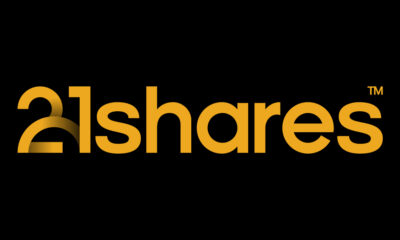
 Nyheter4 veckor sedan
Nyheter4 veckor sedanCrypto Market Risks & Opportunities: Insights on Bybit Hack, Bitcoin, and Institutional Adoption
-
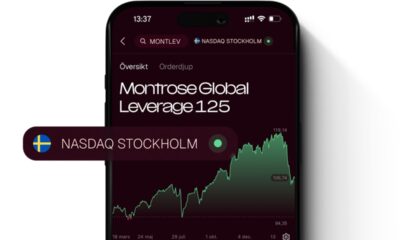
 Nyheter4 veckor sedan
Nyheter4 veckor sedanMontrose storsatsning på ETFer fortsätter – lanserar Sveriges första globala ETF med hävstång
-

 Nyheter4 veckor sedan
Nyheter4 veckor sedanSvenskarna har en ny favorit-ETF
-
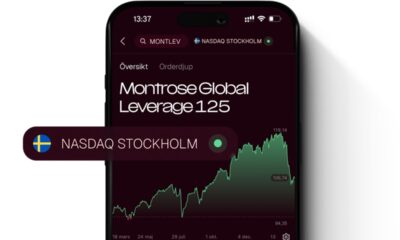
 Nyheter4 veckor sedan
Nyheter4 veckor sedanMONTLEV, Sveriges första globala ETF med hävstång
-

 Nyheter3 veckor sedan
Nyheter3 veckor sedanSju börshandlade fonder som investerar i försvarssektorn
-

 Nyheter3 veckor sedan
Nyheter3 veckor sedanVärldens första europeiska försvars-ETF från ett europeiskt ETF-företag lanseras på Xetra och Euronext Paris
-

 Nyheter4 veckor sedan
Nyheter4 veckor sedanEuropeisk försvarsutgiftsboom: Viktiga investeringsmöjligheter mitt i globala förändringar
-

 Nyheter3 veckor sedan
Nyheter3 veckor sedan21Shares bildar exklusivt partnerskap med House of Doge för att lansera Dogecoin ETP i Europa


